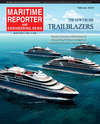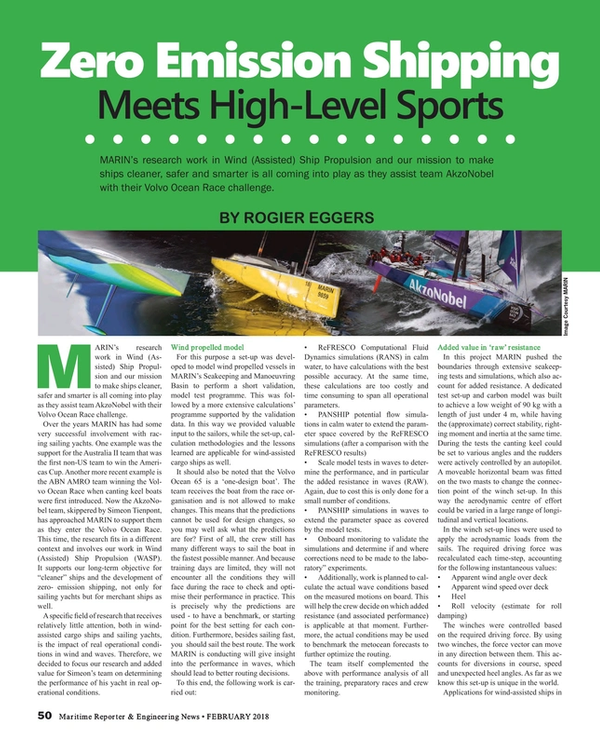
Volvo Ocean Race: Zero Emission Shipping Meets High-Level Sports
By Rogier Eggers, MARIN
MARIN’s research work in Wind (Assisted) Ship Propulsion and our mission to make ships cleaner, safer and smarter is all coming into play as they assist team AkzoNobel with their Volvo Ocean Race challenge.
By Rogier Eggers, MARIN
MARIN’s research work in Wind (Assisted) Ship Propulsion and our mission to make ships cleaner, safer and smarter is all coming into play as they assist team AkzoNobel with their Volvo Ocean Race challenge.
Over the years MARIN has had some very successful involvement with racing sailing yachts. One example was the support for the Australia II team that was the first non-US team to win the Americas Cup. Another more recent example is the ABN AMRO team winning the Volvo Ocean Race when canting keel boats were first introduced. Now the AkzoNobel team, skippered by Simeon Tienpont, has approached MARIN to support them as they enter the Volvo Ocean Race. This time, the research fits in a different context and involves our work in Wind (Assisted) Ship Propulsion (WASP). It supports our long-term objective for “cleaner” ships and the development of zero- emission shipping, not only for sailing yachts but for merchant ships as well.
A specific field of research that receives relatively little attention, both in wind-assisted cargo ships and sailing yachts, is the impact of real operational conditions in wind and waves. Therefore, we decided to focus our research and added value for Simeon’s team on determining the performance of his yacht in real operational conditions.
Wind propelled model
For this purpose a set-up was developed to model wind propelled vessels in MARIN’s Seakeeping and Manoeuvring Basin to perform a short validation, model test programme. This was followed by a more extensive calculations’ programme supported by the validation data. In this way we provided valuable input to the sailors, while the set-up, calculation methodologies and the lessons learned are applicable for wind-assisted cargo ships as well.
It should also be noted that the Volvo Ocean 65 is a ‘one-design boat’. The team receives the boat from the race organisation and is not allowed to make changes. This means that the predictions cannot be used for design changes, so you may well ask what the predictions are for? First of all, the crew still has many different ways to sail the boat in the fastest possible manner. And because training days are limited, they will not encounter all the conditions they will face during the race to check and optimise their performance in practice. This is precisely why the predictions are used - to have a benchmark, or starting point for the best setting for each condition. Furthermore, besides sailing fast, you should sail the best route. The work MARIN is conducting will give insight into the performance in waves, which should lead to better routing decisions.
To this end, the following work is carried out:
• ReFRESCO Computational Fluid Dynamics simulations (RANS) in calm water, to have calculations with the best possible accuracy. At the same time, these calculations are too costly and time consuming to span all operational parameters.
• PANSHIP potential flow simulations in calm water to extend the parameter space covered by the ReFRESCO simulations (after a comparison with the ReFRESCO results)
• Scale model tests in waves to determine the performance, and in particular the added resistance in waves (RAW). Again, due to cost this is only done for a small number of conditions.
• PANSHIP simulations in waves to extend the parameter space as covered by the model tests.
• Onboard monitoring to validate the simulations and determine if and where corrections need to be made to the laboratory” experiments.
• Additionally, work is planned to calculate the actual wave conditions based on the measured motions on board. This will help the crew decide on which added resistance (and associated performance) is applicable at that moment. Furthermore, the actual conditions may be used to benchmark the metocean forecasts to further optimize the routing.
The team itself complemented the above with performance analysis of all the training, preparatory races and crew monitoring.
Added value in ‘raw’ resistance
In this project MARIN pushed the boundaries through extensive seakeeping tests and simulations, which also account for added resistance. A dedicated test set-up and carbon model was built to achieve a low weight of 90 kg with a length of just under 4 m, while having the (approximate) correct stability, righting moment and inertia at the same time. During the tests the canting keel could be set to various angles and the rudders were actively controlled by an autopilot. A moveable horizontal beam was fitted on the two masts to change the connection point of the winch set-up. In this way the aerodynamic centre of effort could be varied in a large range of longitudinal and vertical locations.
In the winch set-up lines were used to apply the aerodynamic loads from the sails. The required driving force was recalculated each time-step, accounting for the following instantaneous values:
• Apparent wind angle over deck
• Apparent wind speed over deck
• Heel
• Roll velocity (estimate for roll damping)
The winches were controlled based on the required driving force. By using two winches, the force vector can move in any direction between them. This accounts for diversions in course, speed and unexpected heel angles. As far as we know this set-up is unique in the world.
Applications for wind-assisted ships in this same test set-up could be:
• The combined (steady) heel and (dynamic) roll and the influence of sails in this
• The course keeping ability in stern quartering wind and waves (probably with very little propeller flow over the rudders and large roll and yaw wave excitation)
• The possibility to meet zig-zag IMO requirements.
After a little tuning, the PANSHIP simulations corresponded very well with the test results. The overall calculations matrix yielded the added resistance as a function of wave height, relative direction, period, ship speed, heel angle and various boat settings. This is a much more detailed description compared to the typical empirical calculation with only two or so parameters. The variations within the more extensive parameter space can in fact be very relevant as shown in Figure 2. Although specific numbers will be shared only after the race, it can clearly be seen that the added resistance varies significantly with heading (green versus red line).
MARIN was able to provide valuable information to team AkzoNobel to calibrate their performance in calm water and to make better routing decisions to allow for the performance degradation in seas. At the same time, the project has yielded spin-offs with lessons learnt and an improved test set-up that can also be used for wind-assisted vessels.
About the Author
Rogier Eggers is senior project manager at the business unit Ships at MARIN, the Maritime Research Institute Netherlands.
As published in the February 2018 edition of Maritime Reporter & Engineering News: https://magazines.marinelink.com/nwm/MaritimeReporter/201802/
Read Volvo Ocean Race: Zero Emission Shipping Meets High-Level Sports in Pdf, Flash or Html5 edition of February 2018 Maritime Reporter
Other stories from February 2018 issue
Content
- Analysis: Government Proposal 'Ill-informed' on Maritime Matters page: 10
- Maritime & Strict Liability Criminal Statutes page: 12
- Tugboats & Vessel Response Plans page: 12
- Data is the New Oil and Satellites Are the Pipeline page: 22
- New Research in Biofilms: Fighting Nature with Nature page: 24
- How Much is That Superyacht Worth? page: 28
- Adventure Bound: Sunstone Ships Climbs to New Heights page: 32
- Luxury Cruise Ships & The French Connection page: 38
- Cruise Ships & Eco-Trends in Energy Transition page: 44
- Global Sulfur Cap: Maritime Must Prepare Now page: 48
- Volvo Ocean Race: Zero Emission Shipping Meets High-Level Sports page: 50
- Eco Ships: The New Norm for Top Tier Ships page: 52
- Krilo Jesenice: Village of the Cruisers page: 60
- Tech File: Fuel Monitoring Matters page: 66


